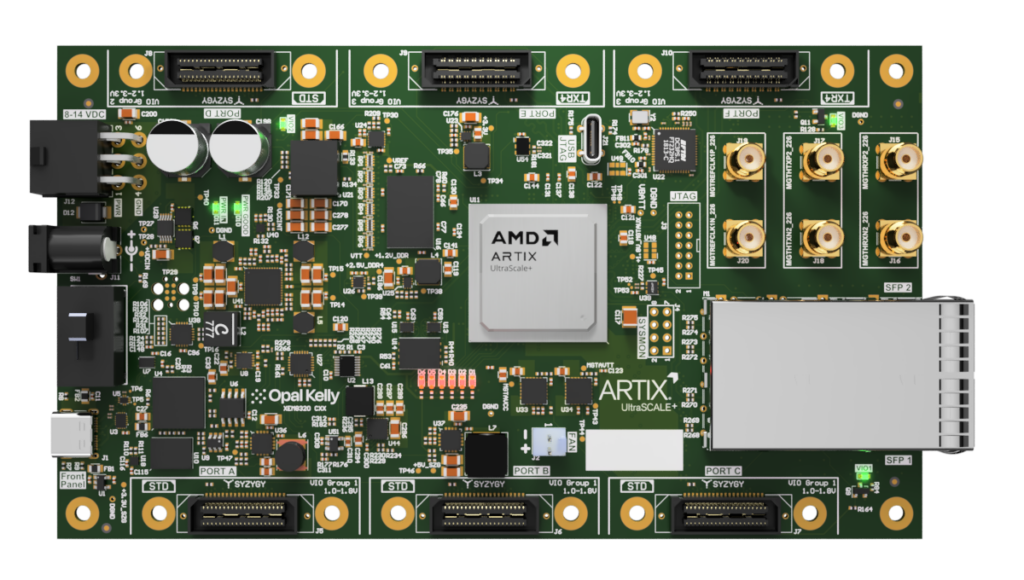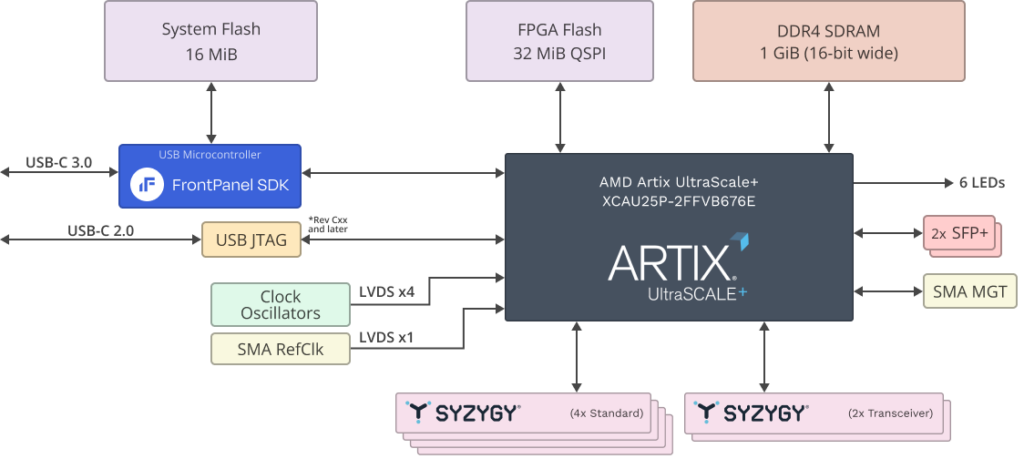Introduction
The Opal Kelly XEM8320-AU25P is the official development platform for the AMD Artix UltraScale+ FPGA. The XEM8320 is supported by Opal Kelly’s FrontPanel SDK, enabling a new level of rapid prototype development and a path to production deployment with the associated XEM8310 module.
Six SYZYGY ports provide expansion capabilities with external peripherals for data acquisition, signal generation, digital communication, sensing, networking, advanced interfacing, and more.

Documentation and Reference Materials
The following is a comprehensive list of documentation available for this device.
| XEM8320 User’s Manual | This online documentation space. |
| XEM8320 Schematics | Download the schematics in a PDF. |
| XEM8320 Pins Reference | The interactive Pins reference for the device provides detailed pinout information as well as automated constraint file generation. Export functionality is provided to PDF, CSV. Constraint files are provided in XDC format for use in Vivado. |
| FrontPanel SDK User’s Manual | The online documentation space for the FrontPanel SDK. |
| FrontPanel API Reference | Online API reference with detailed usage for every API method. |
Functional Block Diagram

FPGA
The XEM8320 is offered in a single variant with the AU25P density and -2 speed grade Artix UltraScale+ FPGA. The table below briefly summarizes the key features of this FPGA. Please consult the AMD documentation for a more thorough comparison.
| FEATURE | XEM8320-AU25p |
|---|---|
| FPGA | XCAU25P-2FFVB676E |
| System Logic Cells | 308,437 |
| CLB Flip-Flops | 282,000 |
| CLB LUTs | 141,000 |
| Max. Distributed RAM | 4.7 Mb |
| Block RAM | 300 blocks (10.5 Mb) |
| DSP Slices | 1,200 |
| CMTs (1 MMCM + 2 PLLs) | 4 |
| Max HP I/O | 208 |
| Max HD I/O | 96 |
| GTY Transceivers (16.375 Gb/s) | 12 |
SuperSpeed USB 3.0 Interface
The XEM8320 uses a Cypress FX3 USB microcontroller to make the XEM a USB 3.0 peripheral. As a USB peripheral, the XEM is instantly recognized as a plug and play peripheral on millions of PCs. More importantly, FPGA downloads to the XEM happen quickly, virtual instruments under FrontPanel update quickly, and data transfers are blazingly fast.
On-board Peripherals
The XEM8320 is designed to compactly support a large number of applications with a small number of on-board peripherals. These peripherals are listed below.
Low-Jitter Crystal Oscillators
The following fixed-frequency low-jitter oscillators are included on-board with direct connections to the FPGA:
- 100 MHz for FPGA fabric
- 100 MHz for DDR4 memory operations
- 125 MHz for FPGA transceiver reference
All oscillators route their LVDS clock to the FPGA. The Artix UltraScale+ FPGA can produce a wide range of clock frequencies using the on-chip MCM capabilities.
1-GiByte Word-Wide DDR4 Synchronous DRAM
The module also includes 1-GiByte DDR4 SDRAM with a 16-bit wide interface to the FPGA. This SDRAM is attached exclusively to the FPGA. The maximum data rate of the SDRAM is 2666 Mb/s, although the -2 speed grade of the Artix UltraScale+ FPGA supports a maximum data rate of 2400 Mb/s. This gives a supported peak memory bandwidth of 38.4 Gb/s.
FPGA Flash – 32 MiB QPSI Flash Memory
A 256 Mib serial flash device provides on-board non-volatile storage for the FPGA including fast boot capability. This device is attached directly to the FPGA for use in your design.
System Flash – 16 MiB Serial Flash Memory
A 128 Mib serial flash device provides on-board non-volatile storage accessible to the USB microcontroller. This device is used to store device firmware and configuration settings as well as other user assets such calibration data. Erase, read, and write functions are available at all times (with or without a configured FPGA) through the use of FrontPanel API methods.
LEDs
Six LEDs are available for general use as indicators.
SYZYGY Expansion Connectors
Six high-density SYZYGY Compatible expansion connectors are available on the XEM8320 for high-performance peripheral expansion. For more details, please review the SYZYGY Specification. Additional details for these ports are available in the XEM8320 SYZYGY Ports documentation.
| XEM8320 PORT | SYZYGY TYPE |
|---|---|
| PORT A | Standard |
| PORT B | Standard |
| PORT C | Standard |
| PORT D | Standard |
| PORT E | Transceiver |
| PORT F | Transceiver |
FrontPanel Support
The XEM8320 is fully supported by Opal Kelly’s FrontPanel Application. FrontPanel augments the limited peripheral support with a host of PC-based virtual instruments such as LEDs, hex displays, pushbuttons, toggle buttons, and so on. Essentially, this makes your PC a reconfigurable I/O board and adds tremendous value to the XEM8320 as an experimentation or prototyping system.
Programmer’s Interface
In addition to complete support within FrontPanel, the XEM8320 is also fully supported by the FrontPanel SDK, a powerful C++ class library available to Windows, Mac OS X, and Linux programmers allowing you to easily interface your own software to the XEM.
In addition to the C++ library, wrappers have been written for C#, Java, and Python making the API available under those languages as well. Sample wrappers (unsupported) are also provided for Matlab and LabVIEW.
Complete documentation and several sample programs are installed with FrontPanel.
Copyright
Software, documentation, samples, and related materials are Copyright © 2006-2021 Opal Kelly Incorporated.
Opal Kelly Incorporated
Portland, OR
https://www.opalkelly.com
All rights reserved. Unauthorized duplication, in whole or part, of this document by any means except for brief excerpts in published reviews is prohibited without the express written permission of Opal Kelly Incorporated.
Opal Kelly® and FrontPanel® are registered trademarks of Opal Kelly Incorporated. Linux is a registered trademark of Linus Torvalds. Microsoft and Windows are both registered trademarks of Microsoft Corporation. All other trademarks referenced herein are the property of their respective owners and no trademark rights are claimed.